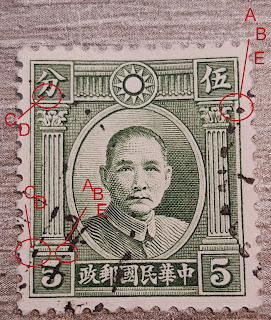5 cents
for the 5 cents stamp in the 1st Sun Yat-sen series, there are not less then 5 different types.
In the 'narrow' version, we can find subtype A, C and D - and in the 'wide' version, subtypes A, B, C, D and E.
 |
| 4 spots, to spot the differences |
To find the different subtypes, we have to look at 4 different places, the two square frames on the top, and the square frame on the left bottom.
Picture 1 : subtype A, B and E depends on the bottom frame line of the top square.
In A (also in C and D) it is intact. In B and E it is partly or complete broken.
In the picture above, the line appears thinner towards the end.
The second 'check' will show it is a subtype E.
Picture 2 shows the 'FUN' sign 分 (fun = cent). Subtype C has an intact 'fun' sign, subtype D a broken 'fun' sign.
The catalog mentions a 'broken hook' for this type.
I did not find any copy with this difference, but I found a stamp where the other stroke is open at the bottom and not closed like all other ones.
Maybe it's just an accidental error or a plate flaw?
 |
| intact 'hook' but open left stroke ? |
The differences mentioned above, are in combination with specific variations at the bottom of the stamp, as shown below:
Picture 3 is in combination with picture 1 and 2:
For subtype A, not only the frame line top has to be intact, also the vertical lines at the bottom of the pillar need to be regular.
For subtype B and E the top line is thin or partly missing, but B has a regular set of vertical lines below the pillar, while subtype E misses one vertical line in the row (see picture above).
For both subtypes C and D, the 'fun' sign is potentially intact of broken, but the series of vertical lines below the pillar are short and thick on the left, and regular from the middle to the right.
Best is to check this part first, before looking to the (less) 'fun' part.
Once determinated the subtypes, look if the stamp belongs to the 'narrow' or the 'wide' group.
The narrow group knows subtypes A, C and D - the wide group has all 5 subtypes.
Narrow subtype D is the rarest.
to be continued ...



No comments:
Post a Comment